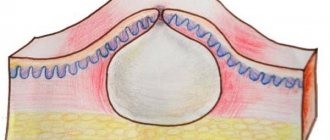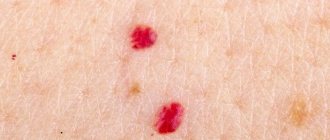More and more women after the age of forty are faced with breast fibrolipoma. What it is, what are the reasons for the formation and development of a tumor, what symptoms occur with this disease, how it is diagnosed and treated, all women need to know. No one is immune from hormonal changes, which lead to a benign breast tumor – fibrolipoma.
In some cases, the tumor becomes calcified, but almost never becomes malignant. The diagnosis of fibrolipoma is made after a physical and instrumental examination of the mammary glands. To treat the disease, surgical removal is indicated. With a small education, only observation is required. Before being treated with traditional methods, it is best to find out the opinion of doctors about a particular recipe.
What is fibrolipoma
Fibrolipoma is a benign neoplasm. This is a dense, mobile and painless neoplasm, consisting of adipose and fibrous tissue. The tumor has no adhesions to the skin or surrounding tissues, so during palpation examination of the mammary gland it easily rolls from place to place. The disease occurs without symptoms for a long time. If the formation grows to gigantic proportions, then breast deformation becomes noticeable.
The breasts of women over forty years of age are susceptible to various neoplasms, one of which is breast fibrolipoma. Rarely, tumor growth can be observed in women of reproductive age and even in young girls. Most often, fibrolipoma affects only one breast. In exceptional cases, doctors identify multiple lipomas that affect not only breast tissue, but also other parts of the body. This disease is called lipomatosis.
A formation of adipose and fibrous tissue can remain in a woman’s breast for decades, without growing or manifesting itself in any way. But having begun to grow rapidly, especially with the onset of menopause, fibrolipomas can degenerate malignantly. For this reason, it is better not to wait until the tumor begins to grow rapidly, but after consultation with a mammologist and examination, perform surgery to remove the tumor.
There are two types of formations, consisting of fibrous and adipose tissue. They differ in the amount of a certain fabric in the composition. Fibrolipoma, for the most part, consists of fibrous tissue. Another option, when the tumor is dominated by adipose tissue, doctors call this neoplasm a lipofibroma. The second type of pathology is much less common, so any fibro-fatty tumor in the breast is generally called fibrolipoma.
We recommend reading Brain glioma - causes, classification, treatment
General characteristics of the pathology
Soft tissue fibrolipoma is a compaction in the subcutaneous layer, the formation of which involves adipose and connective epithelium. A tumor may be composed of varying amounts of these types of tissue. A lipoma with a predominance of fat is a lipofibroma. The saturation of the neoplasm with connective fiber indicates the presence of fibrolipoma.
A knot that is dense to the touch with clear edges and a movable structure is formed on the surface of the skin. The consistency of the neoplasm may depend on the location and organ of the lesion.
Breast fibrolipoma is characterized by a dense structure with the formation of a stalk. In the stomach, lung or kidney, the tumor is oval in shape with the densest consistency.
The nature of the pathology is benign, but doctors advise not to delay treatment and contact the clinic at the first signs of discomfort. The node grows slowly without pain. Fibrolipoma has a smooth structure with the presence of a stalk, which gives a certain mobility.
Pain appears when the node is mechanically injured or grows to a large size, when pressure occurs on nearby tissues with blood vessels and nerve endings in the muscle. The disease can provoke an increase in blood pressure, followed by swelling of the soft tissues and necrosis of the affected areas.
ICD-10 pathology code D17 “Benign neoplasm of adipose tissue.” The disease affects people of different age groups - it is more common in adults. Women suffer from this pathology more often, especially at the age of 30-45 years. The tumor can occur on the back of the neck, on the back, on the leg, in the thigh area, affect the stomach and chest, and anywhere on the surface layer of the skin.
Causes
The exact reasons why breast fibrolipoma develops have not been established. Many researchers are convinced that this is due to failures in the formation of adipose tissue cells, which occur during the period of intrauterine development. Others believe that the reason is general disturbances in the functioning of the body. The most common belief is that tumor growth can be triggered by serious hormonal changes, which explains the prevalence of pathology during and before menopause.
In addition, the risk of fibrolipoma increases with:
- diseases of the pancreas and thyroid gland;
- liver failure and adrenal diseases;
- diseases of the pituitary gland of the brain;
- diabetes mellitus;
- alcoholism and smoking;
- frequent stress and nervous overload;
- metabolic disorders.
In some cases, there is a hereditary predisposition to tumor formation.
Danger and types of lipofibroma
Need advice from an experienced doctor?
Get a doctor's consultation online. Ask your question right now.
Ask a free question
The disease cannot be ignored, despite the benign nature of the tumor on the soft tissues. In the absence of treatment and medical control, calcium salts begin to be deposited inside the capsule. Connective tissue and fat are converted into cartilage, which, when in contact with the skin and skeleton, causes pain and impairs motor activity.
Statistics show that fibrolipoma is not prone to degeneration into cancer. But twisting the stem of the cone, physical impact and trauma can trigger the transformation of cells into cancer cells.
Malignancy with a low probability can occur in women during the onset of menopause.
It is necessary to identify the problem in the early stages and correct it in a timely manner.
Symptoms
As a rule, breast fibrolipoma occurs without any symptoms. During an independent examination of the breast or at an appointment with a doctor, a lump in the breast is felt. If the formation is no more than 3 cm and is deep, it may not be palpable, especially if the patient has a large breast size. The skin over the fibrolipoma does not undergo any changes. If the tumor reaches a size of more than 5 cm, the breast begins to deform.
When calcium salts are deposited in the tumor, it becomes hard to the touch. Often, when the tumor becomes calcified, it becomes uncomfortable for a woman to wear her usual underwear. Sometimes discomfort may occur if you press on the area where the fibrolipoma is located. The structure of the tumor is smooth and homogeneous. It may not grow for several years or even decades, and then more than double in a couple of months. The higher the growth rate of fibrous lipoma, the greater the risk of malignant degeneration.
Diagnostics
In order to make a diagnosis of breast fibrolipoma, it is necessary to undergo a thorough examination and differential diagnosis of the tumor with other benign and malignant neoplasms. Diagnosis begins with collecting anamnesis. The doctor will find out what factors could have contributed to the appearance of the tumor, what the symptoms are, what the woman was or is ill with. Next, a palpation examination is carried out, during which the doctor palpates both mammary glands, assesses the symmetry of the breasts, nipple areolas, and checks for any discharge from the glands. An external examination of the skin is also carried out, attention is paid to the severity of the vascular network.
We recommend reading Adrenal adenoma - what it is, symptoms, treatment, causes
Instrumental diagnostic methods include:
- Ultrasound examination (ultrasound);
- Breast X-ray (mammography);
- Computed tomography (CT);
- Magnetic resonance imaging (MRI).
If malignant cell degeneration is suspected, a blood test is taken to determine tumor markers. When diagnosing, a biopsy is performed to remove a small piece of the tumor and its histological examination. Seeing the morphological structure of the neoplasm cells, the doctor can accurately say whether the fibrolipoma has become malignant. As a rule, a preliminary diagnosis can only be made using ultrasound.
Treatment
When treating breast fibrolipoma, it is necessary to be guided by the size of the tumor and the present clinical picture. If the tumor does not bother the patient and is small in size, then in most cases it is not removed. If there is rapid growth and severe symptoms, the tumor is removed. With lipofibroma of the mammary gland, when the tumor contains more fatty tissue than fibrous tissue, it is much easier to cure a woman without surgery, since fat can be affected by various drugs and procedures.
Conservative therapy
It is impossible to act directly on the tumor with any drugs, so treatment of fibrolipoma with medication is not provided. In some cases, the doctor may prescribe medications to regulate hormonal balance, as well as to improve metabolic processes and the general health of the patient.
For small tumors, observation is carried out. The patient must be re-examined annually. Medical removal can also be used, in which a drug that breaks down fatty tissue is injected into the tumor. As a rule, several such procedures are required and they are not able to completely remove the tumor, because the injected drugs do not have any effect on the fibrous tissue that makes up the fibrolipoma.
Surgical intervention
Treatment with surgical intervention is prescribed in cases where:
- a woman feels pain or severe discomfort in the chest;
- the tumor has grown and compresses or displaces internal organs, tissues, blood vessels;
- the tumor grows too quickly;
- the mammary gland is deformed;
- there is suspicion or confirmation of malignancy.
Fibrolipoma in the breast can be removed in several ways:
- Radio wave therapy. During the procedure, high-frequency waves destroy the fatty component of the tumor. The fibrous tissue remains, so the tumor can grow back.
- Puncture removal. A thick puncture needle is inserted into the fibrolipoma, with the help of which the fat cells are removed. Since after the procedure connective tissue remains in the breast in the capsule, there is a high risk of recurrence of the pathology.
- Laser therapy. This method helps to completely remove the tumor without leaving a scar on the patient’s chest.
- Cryodestruction. A small incision (about five millimeters) is made over the fibrolipoma, through which a device is inserted into the mammary gland to freeze and destroy tumor cells with liquid nitrogen or carbon dioxide. After cauterization with nitrogen, an almost imperceptible scar remains on the skin, which gradually lightens and disappears.
- Surgical removal. The operation can be performed in several ways, depending on the size of the tumor and its benignity. The most common procedure is to remove the tumor through a small incision (about one and a half centimeters). For large fibrolipomas, sectoral resection may be indicated, in which the tumor capsule is removed along with surrounding tissue at a distance of one to three centimeters around it.
We recommend reading Brain cavernoma - what it is, treatment, causes
Possible complications after surgery are prevented by anti-inflammatory and antibacterial drugs, as well as vitamin complexes and immunomodulators.
ethnoscience
It is impossible to cure fibrolipoma using traditional methods, but they can help eliminate provoking factors. Any home treatment must be agreed upon with the doctor who made the diagnosis. During therapy, various medicinal plants are used, for example, coltsfoot, chamomile, chaga, boron uterus, burdock root, St. John's wort. Infusions and tinctures, ointments, lotions and compresses are prepared from natural ingredients. Traditional medicine should not and cannot replace tumor removal in a hospital.
Is it possible to do a puncture for lipofibroma during pregnancy?
There are suspicions that it is a lipofibroma. Is it worth doing a puncture during pregnancy? A puncture is one of many research methods and is an invasion into the mammary gland to take a sample of tumor tissue. After which the material is sent for diagnostics. This is the most current method for identifying or excluding the presence of cancer cells in a pathological breast formation. The result of a cytological analysis of fluid removed with a thin long needle may depend on the professionalism of the specialist who conducts it. The accuracy of the research is close to 90%.
There are contraindications to carrying out this method of studying the material taken: these are allergies to painkillers, the period of breastfeeding and pregnancy.
Prevention and prognosis
To prevent fibrolipoma, it is necessary to eliminate factors that can provoke its appearance. A woman must promptly treat diseases of the endocrine system and kidneys. In order not to miss the onset of the development of pathology, you need to be examined by a gynecologist every six months and once a year by a mammologist. It is very important to conduct an independent manual breast examination, which can be learned in any gynecological office. If you consult a doctor in a timely manner, the prognosis for patients with fibrolipoma is favorable.
Pathology prognosis
The prognosis for the disease is generally positive. Early detection of a tumor allows for painless removal of the pathological formation. The occurrence of complications with relapse is rarely diagnosed.
The consequences of long-term development of pathology without therapy are:
- degeneration of an atypical cell into a malignant form;
- inflammation inside the capsule due to mechanical injury;
- displacement of nearby organs and tissues due to the formation of a wen.
Contacting the clinic at the first signs of illness and palpation of a suspicious lump helps to carry out timely treatment without serious consequences.










